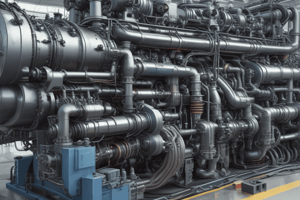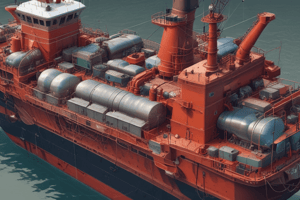Podcast
Questions and Answers
Explain why the air outlet from the turbocharger should be cooled before entering the diesel engine cylinder.
Explain why the air outlet from the turbocharger should be cooled before entering the diesel engine cylinder.
Cooling the air outlet reduces the temperature of the air entering the cylinder, which increases the density of the air charge and improves combustion efficiency.
Explain why the charge air cooler has fins attached to its tubes.
Explain why the charge air cooler has fins attached to its tubes.
Fins increase the surface area for heat exchange, improving the efficiency of the cooler.
State possible reasons why the charge air cooler's performance may be reduced.
State possible reasons why the charge air cooler's performance may be reduced.
Possible reasons include blockages, fouling due to dirt or oil, or damage to the cooler itself.
Identify the component parts A-E of the timing chain section.
Identify the component parts A-E of the timing chain section.
Explain the reasons why chains may elongate or slacken in service.
Explain the reasons why chains may elongate or slacken in service.
Describe a procedure for manually testing the set points on a diesel generator's HT cooling water.
Describe a procedure for manually testing the set points on a diesel generator's HT cooling water.
Sketch a scroll type fuel pump and label the main components.
Sketch a scroll type fuel pump and label the main components.
Explain how the pump sketched in part (a) may vary the end of delivery.
Explain how the pump sketched in part (a) may vary the end of delivery.
Explain the meaning of the term microbial contamination in diesel fuel.
Explain the meaning of the term microbial contamination in diesel fuel.
Describe the possible problems the engine may encounter if the fuel received is contaminated with microbes.
Describe the possible problems the engine may encounter if the fuel received is contaminated with microbes.
Explain how microbial contamination can be avoided.
Explain how microbial contamination can be avoided.
Explain the actions to be taken if microbial contamination is severe.
Explain the actions to be taken if microbial contamination is severe.
State FOUR functions of lubricating oil.
State FOUR functions of lubricating oil.
Explain the term hydrostatic lubrication.
Explain the term hydrostatic lubrication.
Explain the term boundary lubrication.
Explain the term boundary lubrication.
State ONE advantage and ONE disadvantage of using grease as a lubricant in a plain bearing.
State ONE advantage and ONE disadvantage of using grease as a lubricant in a plain bearing.
Sketch the assembly of a plate type heat exchanger, labeling the main components and indicating the direction of flow.
Sketch the assembly of a plate type heat exchanger, labeling the main components and indicating the direction of flow.
State the materials used for the plates and seals in a plate type heat exchanger.
State the materials used for the plates and seals in a plate type heat exchanger.
State the purpose of the plates being corrugated in a plate type heat exchanger.
State the purpose of the plates being corrugated in a plate type heat exchanger.
State the purpose of tell tales in a system.
State the purpose of tell tales in a system.
Describe the possible causes and remedies for low lubricating oil pressure in a diesel engine.
Describe the possible causes and remedies for low lubricating oil pressure in a diesel engine.
Describe the possible causes and remedies for overheating in a diesel engine.
Describe the possible causes and remedies for overheating in a diesel engine.
Describe the possible causes and remedies for unstable speed in a diesel engine.
Describe the possible causes and remedies for unstable speed in a diesel engine.
State THREE advantages of a wet clutch.
State THREE advantages of a wet clutch.
State THREE disadvantages of a wet clutch.
State THREE disadvantages of a wet clutch.
State ONE advantage of multiple plates in a clutch system.
State ONE advantage of multiple plates in a clutch system.
State THREE disadvantages of multiple plates in a clutch system.
State THREE disadvantages of multiple plates in a clutch system.
Flashcards are hidden until you start studying
Study Notes
Exam Overview
- Examination on Marine Diesel Engineering held on January 20, 2023.
- Duration: 1400-1600 hours.
- Total marks: 100; passing mark: 50.
- Non-programmable calculators allowed.
- All calculations must show formulae and intermediate steps.
Turbocharger and Engine Components
- Cooling air outlet: Essential to reduce temperature before entering the cylinder, preventing engine knock and improving efficiency.
- Charge air cooler fins: Increase surface area for better heat exchange, enhancing cooling performance.
- Charge air cooler performance issues: Possible causes include clogging, corrosion, and improper maintenance.
Timing Chain and Components
- Component identification: A-E components must be recognized in the provided figure.
- Chain elongation and slackening: Caused by wear, contamination, and poor lubrication; areas prone to wear include sprockets and chain links.
Diesel Generator Testing
- Testing procedure: Manual evaluation of high-temperature cooling water set points must include specific criteria for alarm and shutdown.
Fuel Pump Mechanisms
- Scroll type fuel pump: Sketch and label essential components; functions include fuel delivery regulation.
- Delivery variation: Discuss methods by which the pump adjusts fuel output.
Diesel Engine Fuel Contamination
- Microbial contamination: Defined as the presence of microbes in fuel.
- Problems from contamination: Potential issues include clogged filters, injector damage, and efficiency loss.
- Prevention methods: Implement filtration, maintain cleanliness, and manage storage conditions.
- Actions for severe contamination: Recommended measures include fuel system cleaning and thorough inspection.
Functions of Lubricating Oil
- Key functions: Includes reducing friction, cooling engine parts, sealing, and cleaning.
- Lubrication types:
- Hydrostatic lubrication: uses fluid pressure.
- Boundary lubrication: occurs under low film thickness.
- Grease in plain bearings: Advantage – good adhesion; Disadvantage – limited heat dissipation.
Plate Type Heat Exchangers
- Assembly sketch: Must illustrate main components and flow direction.
- Materials: Commonly used materials include stainless steel and rubber for plates and seals.
- Corrugated plates: Serve to enhance turbulence and heat transfer efficiency.
- Tell tales: Used for indicating heat exchanger performance or leak detection.
Diesel Engine Faults
- Low lubricating oil pressure: Causes can include pump failure, leaks, and contaminated oil.
- Overheating: Possible reasons are inadequate cooling, faulty thermostats, or blockages.
- Unstable speed: Common issues linked to fuel delivery problems, engine load variations, or control system failures.
Friction Clutches
- Wet clutch advantages: Provide smoother engagement, cooler operation, and better torque handling.
- Wet clutch disadvantages: Increased complexity, potential for leaks, and higher maintenance needs.
- Multiple plates advantages: Higher torque capacity in compact design.
- Multiple plates disadvantages: Increased cost, complexity, and potential for uneven wear.
Studying That Suits You
Use AI to generate personalized quizzes and flashcards to suit your learning preferences.




